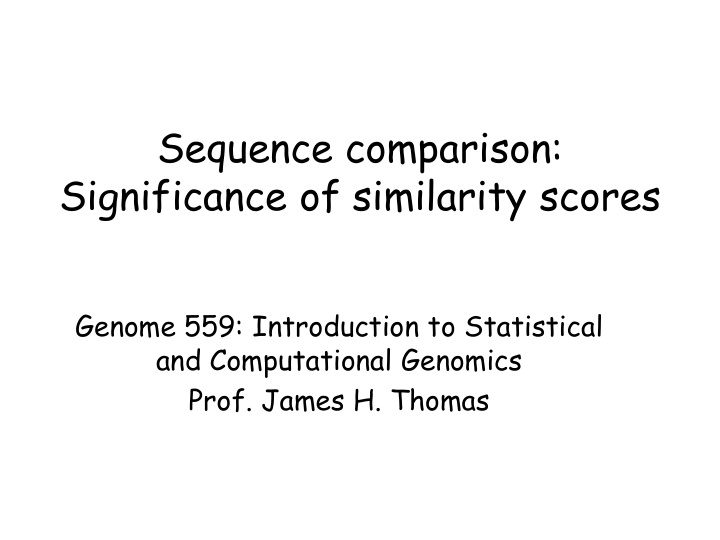



Sequence comparison: Significance of similarity scores Genome 559: Introduction to Statistical and Computational Genomics Prof. James H. Thomas
The null hypothesis • We are interested in characterizing the distribution of scores from pairwise sequence alignments. • We measure how surprising a given score is, assuming that the two sequences are not related. • This assumption is called the null hypothesis. • The purpose of most statistical tests is to determine whether the observed result(s) provide a reason to reject the null hypothesis.
Sequence similarity score distribution Frequency Sequence comparison score • Search a randomly generated database of sequences using a given query sequence. • What will be the form of the resulting distribution of pairwise sequence comparison scores?
Unscaled EVD equation characteristic width x ( ) e P S x 1 e S is data score, x is test score (FYI this is 1 minus the cumulative peak centered density function or CDF) on 0
Scaling the EVD • An EVD derived from, e.g., the Smith-Waterman algorithm with BLOSUM62 matrix and a given gap penalty has a characteristic mode μ and scale parameter λ . x ( x ) ( ) e ( e ) scaled: P S x 1 e P S x 1 e and depend on the size of the query, the size of the target database, the substitution matrix and the gap penalties.
Similar to scaling the standard normal 2 x 2 PDF Ce snormal where C 1 2 2 ( x ) 2 v PDF Ce gnormal where C 1 2 v standard and is variance v normal ( adjusts peak and v adjusts width)
An example You run BLAST and get a score of 45. You then run BLAST on a shuffled version of the database, and fit an EVD to the resulting empirical distribution. The parameters of the EVD are = 25 and = 0.693 . What is the p-value associated with score 45? 0.693 45 25 ( e ) 45 1 P S e 13.86 ( ) e 1 e 7 9.565 10 1 e 1 0.999999043 7 9.565 10 BLAST has precomputed values of and for all common matrices and gap penalties (and the run scales for the size of the query and database)
What p-value is significant? • The most common thresholds are 0.01 and 0.05. • A threshold of 0.05 means you are 95% sure that the result is significant. • Is 95% enough? It depends upon the cost associated with making a mistake. • Examples of costs: – Doing extensive wet lab validation (expensive) – Making clinical treatment decisions (very expensive) – Misleading the scientific community (very expensive) – Doing further simple computational tests (cheap) – Telling your grandmother (very cheap)
Multiple testing • Say that you perform a statistical test with a 0.05 threshold, but you repeat the test on twenty different observations (e.g. 20 different blast runs) • Assume that all of the observations are explainable by the null hypothesis. • What is the chance that at least one of the observations will receive a p-value of 0.05 or less?
Bonferroni correction • Assume that individual tests are independent . • Divide the desired p-value threshold by the number of tests performed.
Database searching • Say that you search the non-redundant protein database at NCBI, containing roughly one million sequences (i.e. you are doing 10 6 pairwise tests). What p-value threshold should you use? • Say that you want to use a conservative p-value of 0.001. • Recall that you would observe such a p-value by chance approximately every 1000 times in a random database.
E-values • A p-value is the probability of making a mistake. • An E-value is the expected number of times that the given score would appear in a random database of the given size. • One simple way to compute the E-value is to multiply the p-value times the size of the database. • Thus, for a p-value of 0.001 and a database of 1,000,000 sequences, the corresponding E-value is 0.001 1,000,000 = 1,000. (BLAST actually calculates E-values in a different way, but they mean about the same thing)
Summary • A distribution plots the frequencies of types of observation. • The area under the distribution curve is 1. • Most statistical tests compare observed data to the expected result according to a null hypothesis. • Sequence similarity scores follow an extreme value distribution, which is characterized by a long tail. • The p-value associated with a score is the area under the curve to the right of that score. • Selecting a significance threshold requires evaluating the cost of making a mistake. • Bonferroni correction: Divide the desired p-value threshold by the number of statistical tests performed. • The E-value is the expected number of times that a given score would appear in a randomized database.
Recommend
More recommend